A long time ago in a service bay far away, the average tread life of a bias ply tire was 20,000 miles. Even with belted bias ply tires, you did well to get 30,000 miles. Shocks, ball joints and bushings averaged out at 40,000. Today, modern radials can get 60,000 and suspension parts can go 80,000 to 100,000.
Potholes and road splash take the biggest toll on suspension parts, especially on the vehicle’s right (curb) side. Shocks, struts and ball joints receive the most attention for replacement. Unless the anti-roll bar is making noise, it tends to be missed when the suspension is serviced. This is also true for upper strut bearings and control arm bushings. With so many minivans, crossovers, SUVs, vans and trucks on the road, special attention should be given to the chassis anti-roll bar on these vehicles as the anti-roll bar has a significant affect on a vehicle’s stability during a cornering maneuver as their center of mass is higher than a passenger vehicle.
LATERAL ACCELERATION
Cornering or lateral acceleration causes the chassis to roll. The faster the corner, the more the chassis will tend to roll. During a cornering maneuver, entire weight distribution of the vehicle changes. In a right hand corner, the most weight is placed on the left front wheel. The right rear wheel carries the least amount of weight. If the vehicle is breaking in the corner, even more weight is shifted the right front wheel.
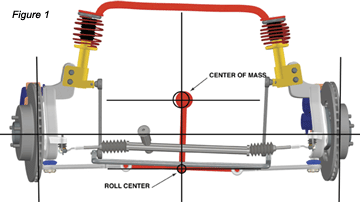
Chassis roll is determined by an axis running from the rear roll center to the front roll center of the vehicle. The axis forms a plane that determines the rotation of the chassis during a corner. The inclination of the plane and center of mass of a vehicle determine how much the chassis roll will occur during a corner. The chassis anti-roll bar is also called a sway bar or stabilizer. It is a mechanical device made up of a formed metal bar that can be solid or hollow and connector links. The bar attaches to the chassis and then links connect it to the lower control arms or struts. The change in position of the control arms will cause the bar to lift the chassis on one side and pull it down on the other depending on the direction of the turn. (See Figure 1.)
CHASSIS CONSTRUCTION
The extremes of vehicle construction can best demonstrate how the roll center and center of mass affects chassis roll. The Corvette is a performance vehicle designed for high speed cornering. It has a roll center that is parallel to and almost at ground level. Its center of mass is very close to the roll center and is located in the center of the vehicle. This produces an almost neutral position during high-speed corners. The ground clearance of the Corvette is minimal, as it is to be driven on maintained paved surfaces.
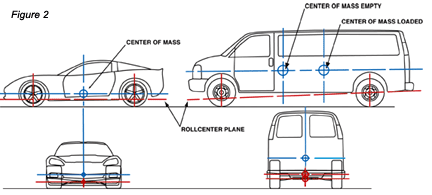
The van is a utility vehicle designed to transport passengers and cargo and its ground clearance is much greater. Its roll center axis is on an incline as the roll center of the rear axle is higher than the control arms of the independent front suspension. Its center of mass is toward the front of the vehicle and can change based on how the vehicle is loaded. The chassis control components of the van will receive more stress under normal service than those in the Corvette. (See Figure 2.)
FRONT-WHEEL DRIVE
The Corvette and van are both rear-wheel-drive vehicles. Most of the passenger vehicles on the road today are front-wheel drive. Chassis roll for these vehicles is a combination of those for the Corvette and van. The roll center for the front-wheel-drive vehicle is the same as the Corvette, as it is parallel to the ground. Its center of mass is like the van in that it is biased toward the front of the vehicle.
The rear suspension of a front-wheel-drive vehicle can range from a fully independent suspension to a beam-type axle. The independent suspension can be a trailing arm, strut or a double wishbone type, all utilizing an anti-roll bar.
The twist beam axle is the most common type used on a great variety of front-wheel-drive vehicles ranging from compact to mid-size. It uses the beam as an anti-roll bar when it is placed at the trailing arm pivot points. The mounting bushings are mounted at an angle toward the center of the vehicle. When the vehicle 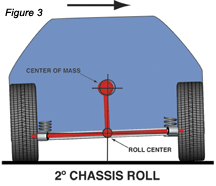 corners to the right, the left trailing arm moves toward a positive camber and caster and the right trailing arm moves toward a negative camber and caster. The clockwise rotation of the chassis on its roll center causes the beam to twist and move the trailing arms toward a zero camber and caster.
corners to the right, the left trailing arm moves toward a positive camber and caster and the right trailing arm moves toward a negative camber and caster. The clockwise rotation of the chassis on its roll center causes the beam to twist and move the trailing arms toward a zero camber and caster.
The bushings are key to the performance of the axle. The type of rubber and its hardness are key to the bushings. New bushings can produce a noise that can be described as a clapping sound when elastomer and hardness are changed from the original design. (See Figure 3.)
DUROMETER
The tires and bushings work with the shocks and struts to produce a given type of feel and ride for the vehicle. The bushings are either natural or synthetic. A durometer is a test instrument to measure the hardness of material. A rubber and plastic durometer is a calibrated spring-loaded specific probe device for measuring hardness. The scale used to measure the hardness of plastics and rubber is the Shore Scale of zero to 100. A quality durometer for rubber and plastics can be purchased for under $400.
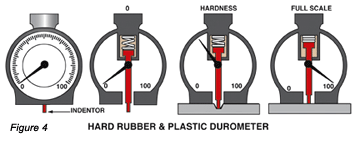
Why would you want to buy a durometer? It can be used to answer questions about tire performance, such as why did these tires wear out so fast or why did you replace those bushings? The softer the tread compound, the faster the tires wear or the bushings have softened when compared to new original equipment ones. (See Figure 4.)
STABILITY CONTROL
Suspension and chassis service to this point have been straightforward processes of replacing worn or broken parts and then aligning the vehicle. This is changing with stability control systems that have been available since the mid 1990s on premium vehicles. In 2004, stability control was made standard on 15 passenger vans. In the 2008 model year, most models will have stability control standard or available. Stability control is mandated by law in 2012 for all vehicles. There are 10-year-old Cadillacs out there with StabiliTrac and other vehicles that need repair.
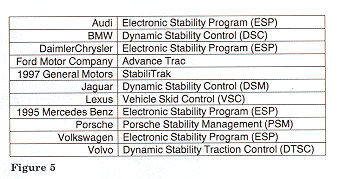
Stability programs use the engine, chassis and brake electronics to control the directional stability based on input and output from these systems. The carmakers use different names for their control programs. (See Figure 5.) The programs use the powertrain, brake and chassis controllers to process input from ABS wheel speed, vehicle speed, engine speed, throttle position, steering wheel position and a yaw sensor. All stability control systems have a yaw sensor. This sensor measures the turning motion of the vehicle.
The program can apply braking to an individual wheel and throttle control to correct the vehicle direction. The program has milliseconds to process the information and react to a change in vehicle direction indicating a loss of control. A combination of worn or damaged bushings, strut bearings or control arms could cause the program to display a warning light on the instrument panel or “Stability Alert” on the  driver information center under normal cornering maneuvers on dry pavement. The driver may not sense the change indicated by the yaw sensor and steering input resulting in the warning. If there is an obvious mechanical failure of a suspension part, such as a strut, that is an easy fix, but replacing the strut may not completely correct the problem. The control arms, strut bearings and anti-roll bar may also be contributing factors. Alignment can also be a contributing factor to the response of the suspension to a steering input. The photographs of the corvette and the van show chassis roll under different conditions. The corvette is in a high speed corner and the van is making a defensive maneuver. The van is using stability control the corvette is not. (See Figure 6.)
driver information center under normal cornering maneuvers on dry pavement. The driver may not sense the change indicated by the yaw sensor and steering input resulting in the warning. If there is an obvious mechanical failure of a suspension part, such as a strut, that is an easy fix, but replacing the strut may not completely correct the problem. The control arms, strut bearings and anti-roll bar may also be contributing factors. Alignment can also be a contributing factor to the response of the suspension to a steering input. The photographs of the corvette and the van show chassis roll under different conditions. The corvette is in a high speed corner and the van is making a defensive maneuver. The van is using stability control the corvette is not. (See Figure 6.)
INSPECTION AND SAFETY
Suspension Noise Vibration and Harshness NVH are isolated from the chassis by the bushings. Every time a vehicle hits a bump or turns a corner, the bushings are stressed by an impact or a twisting motion. Bushings wear out when they lose their elasticity or shape. Struts wear out when they run out of oil. When the vehicle is built, the shocks and struts valves are calibrated to new bushings. Car makers test a vehicle’s suspension for a given number of cycles that would represent X years and Y miles of normal driving. With preventive maintenance reduced to oil and filter changes at a quick oil change shop, the opportunity to inspect the suspension and underside of the vehicle are almost non-existent. With road conditions and driving habits being the major factors in how long a suspension will last, a periodic inspection a true safety concern.









